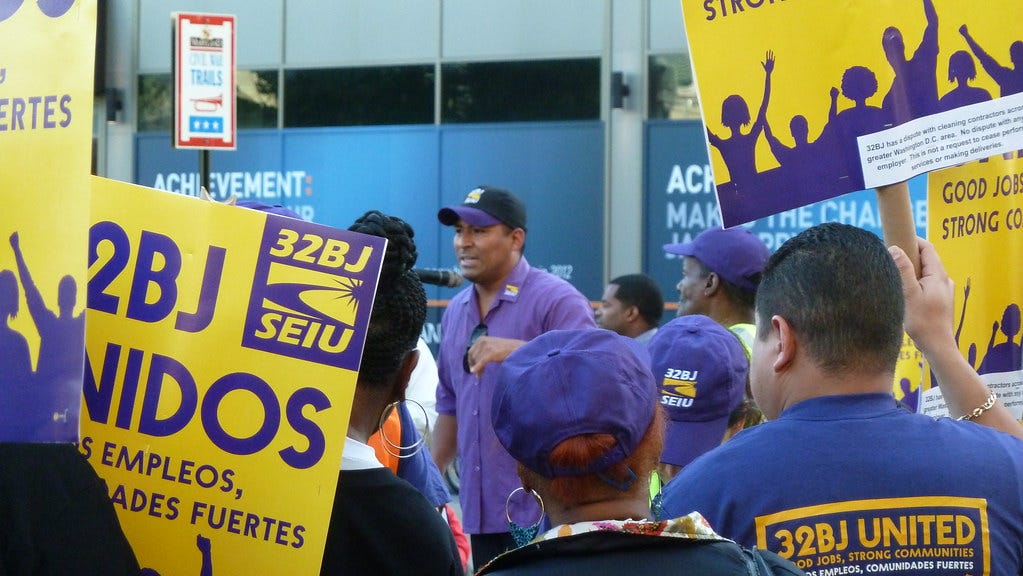How To Make Rallies 'Look and Feel Powerful'
Simple Tips For Activists-on the Left or the Right...and even the Center.
Many unions and other activist groups today use rallies for press conferences, to voice their demands and, otherwise, make themselves (or their “grievances”) known to the public.
This is true of activist groups on the Left and the Right of the political spectrum.
Often, those rallies, when captured by media photographers, social media videographers or television news cameras appear bigger than they actually are.
Well, the writers at Labor Notes, have an article that provides some guidance to enhance the imagery of any rally.
“Good images of powerful strikes, marches, and rallies help us reach a larger audience through the press and social media,” advise Labor Notes’ writers Josh Yoder and Rachel Schragis.
To make a rally appear “larger than life,” Yoder and Schragis provide some simple strategies.
1. REACH THROUGH THE CAMERA
Having the rally organizer encouraging attendees to gather and “reach through the cameras by making noise helps attendees “feel empowered by cameras, and also helps people relax and have more fun.”
Make sure you have a designated photographer or two who can carry this forward. Ask them to take photos throughout the action. You want photos of people cheering, chanting, rallying, listening, marching… rather than a staged photo-op of people smiling at the camera.
2. STAGING TO INCLUDE ALL
“Another way to magnify the feeling of power and unity is to plan where people stand in relation to each other,” Yoder and Schragis write.
Yoder and Schragis advise having the rally attendees stand behind the speaker in order to send “a message of unity.”
This position visually conveys the message that our power comes from numbers….Placing the crowd behind the speaker will consistently make your rally appear more powerful in photos taken by the press—no matter what the accompanying article says.
3. REACHING OUT
Yoder and Schragis suggest assigning greeters to welcome new people and help them find a place to stand behind the speaker.
“In our experience, once they’re behind the speaker, people intuitively understand why they’re there,” Yoder and Schragis write.
Don’t divide your rally attendees. Yoder and Schragis caution against dividing your audience.
Be careful about dividing your audience. It reduces attendance on camera, and can emphasize the divide between the podium and the audience. It also means everyone is facing inward, instead of reaching out to the world.
Plan carefully.
“It’s a good idea to introduce these ideas in the rally planning process, so that everyone who is playing a role understands the goal,” Yoder and Schragis state. “It’s not just about getting good photos; it’s about having a powerful, unified action.”
Read the entire Labor Notes article here.
Editor’s note—Some additional thoughts:
Having attended many rallies over the years (and spoken at a couple), some other observations of some successful (and unsuccessful) rallies:
In the planning stage, coordinate messaging.
K.I.S.S. — Keep It Short & Sweet: Having a simple, understandable message is essential. Having a simple goal, with understandable concepts and talking points is vital. Attendees (and the media) have short attentions spans. If a speaker drones on and on, (s)he will more than likely lose the audience. Remember: Reporters, especially TV reporters, need information in “sound bites” for their stories.
Assign spokespersons (two or three, who can ‘stay on message’)
Provide messaging/talking points for attendees
Rally organizers should expect the press to talk to rally attendees. Therefore, attendees should be armed with talking points (preferably memorized) to give a clear and concise message.
What are the goals and objectives of the rally and/or movement?
From an outsider’s view, one of the failures of the Occupy Wall Street Movement early on was its lack of coherent messaging, which allowed it to devolve into a hodgepodge of different goals and agendas.
Provide Fact Sheets (or Q&As) for the press
Providing as much ‘narrative’ as possible for the media helps reporters write their stories.
Once again, these simple “tips” apply for any activist group—Left or Right—and are key to making rallies ‘look and feel powerful.'
Other Suggested Reading: Saul Alinsky’s Power Tactics






